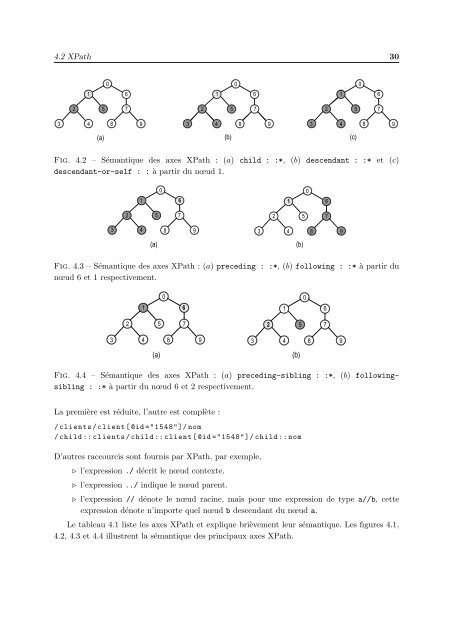Requêtes OLAP sur une base de données XML native - Cercle ...
Requêtes OLAP sur une base de données XML native - Cercle ...
Requêtes OLAP sur une base de données XML native - Cercle ...
You also want an ePaper? Increase the reach of your titles
YUMPU automatically turns print PDFs into web optimized ePapers that Google loves.
(a) (b) (c)<br />
Fig. 1.3. XPath semantics: signposted no<strong>de</strong>s are no<strong>de</strong>s of the result forest if an<br />
(a) 4.2parent::*, XPath (b) ancestor::*, and (c) ancestor-or-self::* step is taken from context 30<br />
no<strong>de</strong> 7.<br />
2<br />
1<br />
3 4<br />
5<br />
0<br />
6<br />
7<br />
8 9<br />
2<br />
1<br />
3 4<br />
5<br />
0<br />
6<br />
7<br />
8 9<br />
2<br />
1<br />
3 4<br />
5<br />
0<br />
6<br />
7<br />
8 9<br />
(a) (b) (c)<br />
1.5. Another <strong>XML</strong> Technologies 17<br />
Fig.<br />
1.5.<br />
4.2<br />
Another<br />
– Sémantique<br />
<strong>XML</strong> Technologies<br />
<strong>de</strong>s axes XPath : (a) child : :*, (b) <strong>de</strong>scendant : :*<br />
17<br />
et (c)<br />
Fig. <strong>de</strong>scendant-or-self 1.4. XPath semantics: : : à 0partirsignposted<br />
du nœud 1. no<strong>de</strong>s are no<strong>de</strong>s of the result forest if an<br />
0<br />
(a) child::*, (b) <strong>de</strong>scendant::*, 1<br />
6 and (c) <strong>de</strong>scendant-or-self::* 1<br />
6 step is taken from<br />
context no<strong>de</strong> 1.<br />
0<br />
0<br />
1.4.2 XQuery2<br />
2<br />
3 4<br />
The XQuery [80] is a hopeful <strong>XML</strong> query language today. A subset of the XPath is a<br />
part of the XQuery but more (a) complex constructs are put into the (b) language. Therefore, the<br />
XQuery Fig. is1.5. said to XPath be too semantics: complex. signposted no<strong>de</strong>s are no<strong>de</strong>s of the result forest if an<br />
Fig. (a) 4.3 preceding::* – Sémantique and <strong>de</strong>s axes (b) following::* XPath : (a) preceding step is taken : :*, from(b) context following no<strong>de</strong> : 6 and :* à1, partir re- du<br />
Fig. 1.5. XPath semantics: signposted no<strong>de</strong>s are no<strong>de</strong>s of the result forest if an<br />
Example nœud spectively. 6 et 11.9 respectivement.<br />
(XQuery queries).<br />
(a) preceding::* and (b) following::* step is taken from context no<strong>de</strong> 6 and 1, respectively.<br />
0<br />
In Listing 1.6 three XQuery queries are shown.<br />
0<br />
1. doc(’books.xml’)/books/book[price50<br />
Fig. or<strong>de</strong>r 4.4 by – $x/name Sémantique <strong>de</strong>s (a) axes XPath : (a) preceding-sibling (b) : :*, (b) followingsibling<br />
return Fig. $x/name : 1.6. :* àXPath partir du semantics: nœud 6 et signposted 2 respectivement. no<strong>de</strong>s are no<strong>de</strong>s of the result forest if an<br />
(a) preceding-sibling::* and (b) following-sibling::* step is taken from context<br />
3. no<strong>de</strong> Fig. 61.6. and 2, XPath respectively. semantics: signposted no<strong>de</strong>s are no<strong>de</strong>s of the result forest if an<br />
La { première (a) preceding-sibling::* est réduite, l’autre est and complète (b) following-sibling::* :<br />
step is taken from context<br />
no<strong>de</strong> for $b 6 and in doc(’books.xml’)/books/book,<br />
2, respectively.<br />
/ clients / client $n in $b/name, [ @id ="1548"]/ nom<br />
/ child :: clients $a in $b/author / child :: client [ @id ="1548"]/ child :: nom<br />
return $n in $b/name,<br />
<br />
D’autres raccourcis $a in $b/author sont fournis par XPath, par exemple,<br />
return { $n }<br />
⊲ l’expression { $a } ./ décrit le nœud contexte.<br />
{ $n }<br />
⊲ l’expression } { $a ../ } indique le nœud parent.<br />
<br />
⊲ l’expression // dénote le nœud racine, mais pour <strong>une</strong> expression <strong>de</strong> type a//b, cette<br />
}<br />
expression dénote n’importe quel nœud b <strong>de</strong>scendant du nœud a.<br />
1.5 Another <strong>XML</strong> Technologies<br />
6<br />
1<br />
3<br />
2<br />
4<br />
3 2 4<br />
5<br />
5<br />
0<br />
7<br />
6<br />
8<br />
7<br />
9<br />
8 9<br />
76<br />
8 7 9<br />
Le tableau 4.1 liste les axes XPath et explique brièvement leur sémantique. Les figures 4.1,<br />
4.2, 1.5 4.3 et 4.4 Another illustrent la sémantique <strong>XML</strong> Technologies<br />
<strong>de</strong>s principaux axes XPath.<br />
There are a lot of technologies related to the <strong>XML</strong>. Due to the fact that this book is aimed<br />
only to in<strong>de</strong>xing <strong>XML</strong> data some of them are briefly <strong>de</strong>scribed. SOAP [91] is the Simple<br />
Object There are Access a lotProtocol of technologies used forrelated invoketo co<strong>de</strong> theoffered <strong>XML</strong>. by Due Web to the services fact that overthis the Internet book is aimed using<br />
<strong>XML</strong> only to and in<strong>de</strong>xing HTTP. <strong>XML</strong> data some of them are briefly <strong>de</strong>scribed. SOAP [91] is the Simple<br />
Object Access Protocol used for invoke co<strong>de</strong> offered by Web services over the Internet using<br />
<strong>XML</strong> and HTTP.<br />
2<br />
1<br />
5<br />
6
















